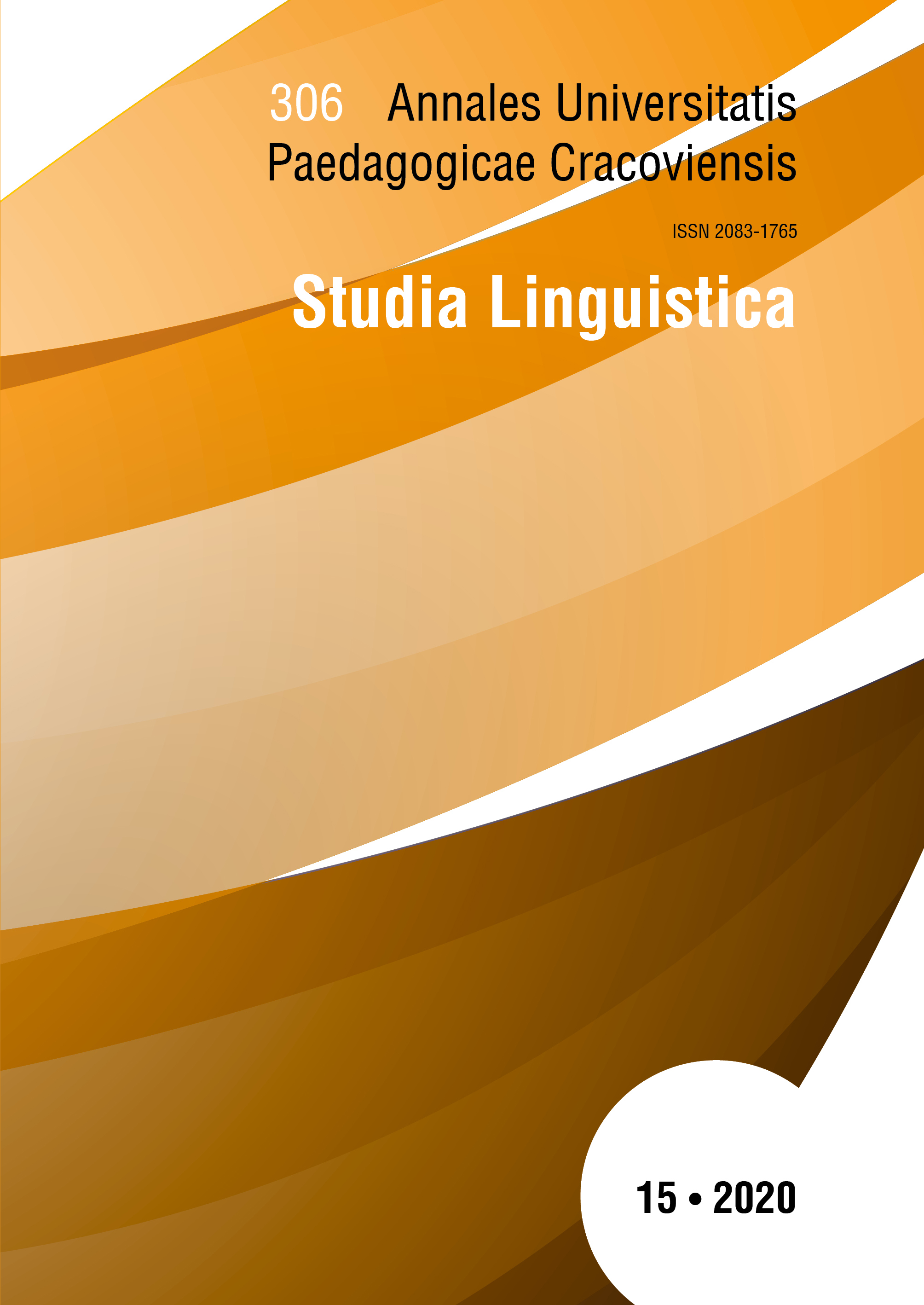Hades not always funeral – a short note on the auspicious names of business entities
Main Article Content
Abstract
The article falls within the chrematonomastic research strand in which a proper name is understood to be a utilitarian message with a pragmatic potential, one that ensues from both statutory requirements and marketing rules. The focus is on the topic of auspicious economic entity names and especially their constituents - lexical units that are supposed to make the name and entity stand out in the market, yet should not be misleading as to what the company’s scope of activity is. The names of firms and premises with the mythological firmonym Hades from various sectors (147 items) from all over Poland, sourced from Panorama Firm, a large business directory, were examined. Quantitatively, the collated material shows that most marketing chrematonyms with this component can be found in the funeral sector, as accounted for by the funeral and thanatological connotations the mythological lexeme evokes by way of its cultural meaning. Much more seldom, name coiners from various sectors (incl. textile, hotel, building, transport, automobile companies) employ the word as well, rendering firmonym-using identification possibly difficult, misleading or nigh on impossible.
Downloads
Article Details

This work is licensed under a Creative Commons Attribution-NonCommercial-NoDerivatives 4.0 International License.
Author, submitting a text to the editorial board of the journal “Annales Universitatis Paedagogicae Cracoviensis. Studia Linguistica", certifies that the content of the article has not been published so far and that the work does not violate in any way the copyright or related rights of other person, as well as other rights of third parties, and that no one's rights to the work (or any part thereof) have been missed. After signing the contract, the property rights to the published materials are transferred to the Scientific Publisher of the University of the National Education Commission, Krakow.
“Annales Universitatis Paedagogicae Cracoviensis. Studia Linguistica” is an open access journal, and all its content is made available free of charge to users and institutions under the Creative Commons CC-BY-NC-ND 4.0 license (attribution, non-commercial use, no derivative works). Under this license, the authors agree that their work may be lawfully reused for any purpose, except for commercial purposes, without the prior consent of the author or publisher. Everyone can read, download, copy, print, distribute and process these works, provided that the author's marking and the original publication place are correct. Published texts may not be used to create derivative works (e.g. to translate and publish in another language without the consent of the publisher). This is in line with the BOAI (Budapest Open Access Initiative) definition. "Studia Linguistica" does not charge for submitting or processing articles.
References
Badyda E., 2007, Od Ozyrysa po Sleep Time. Współczesne tendencje w nazewnictwie polskich zakładów pogrzebowych, „Język Polski” LXXXVII, s. 29–36.
Google Scholar
Badyda E., 2011, O problemach z ustaleniem postaci chrematonimu – na przykładzie nazw polskich wyrobów cukierniczych, [w:] Chrematonimia jako fenomen współczesności, red. M. Biolik, J. Duma, Olsztyn, s. 31–41.
Google Scholar
Badyda E., 2018, Nazewnictwo współczesnych szkół tańca w aspekcie funkcjonalnym – na przykładzie szkół trójmiejskich, „Język – Szkoła – Religia” XIII, nr 2, s. 16–29, https://czasopisma.bg.ug.edu.pl/ index.php/JSR/article/view/975 [dostęp: 19.11.2019].
Google Scholar
Biolik M., 2011, Modele strukturalne nazw własnych przedsiębiorstw i lokali branży gastronomicznej w województwie warmińsko-mazurskim, [w:] Chrematonimia jako fenomen współczesności, red. M. Biolik, J. Duma, Olsztyn, s. 59–78.
Google Scholar
Breza E., 2005, Nazwy zakładów pogrzebowych w Polsce, [w:] Z najnowszych tendencji w polskim nazewnictwie, red. R. Łobodzińska, Łask, s. 69–81.
Google Scholar
Gałkowski A., 2011a, Chrematonimy w funkcji kulturowo-użytkowej. Onomastyczne studium porównawcze na materiale polskim, włoskim i francuskim, Łódź.
Google Scholar
Gałkowski A., 2011b, Chrematonomastyka jako autonomizująca się subdyscyplina nauk onomastycznych, [w:] Chrematonimia jako fenomen współczesności, red. M. Biolik, J. Duma, Olsztyn, s. 181–192.
Google Scholar
Gałkowski A., 2014, Motywacja w procesie tworzenia chrematonimii marketingowej, „Poznańskie Studia Językoznawcze” nr 27: Przestrzenie językoznawstwa. Prace dedykowane Profesor Irenie Sarnowskiej-Giefing, red. M. Graf, s. 63–72.
Google Scholar
Gałkowski A., 2018, Definicja i zakres chrematonimii, „Folia Onomastica Croatica” XXVII, s. 1–14, DOI: https://dx.doi.org/10.21857/mwo1vcz00y
Google Scholar
Nowińska N., 2011, Bardzo czarny PR, czyli społeczne konteksty budowania wizerunku przez firmy pogrzebowe i producentów akcesoriów funeralnych w Polsce, „Ikonosfera. Studia z socjologii i antropologii obrazu”, nr 3, online: http://www.ikonosfera.umk.pl/ fileadmin/ pliki/Ikonosfera_3_ Natalia_Nowinska_ Bardzo_czarny_PR.pdf [dostęp: 6.03.2020].
Google Scholar
Ożóg K., 2008, Zmiany we współczesnym języku polskim i ich kulturowe uwarunkowania, „Język a Kultura”, t. 20: Tom jubileuszowy, red. A. Dąbrowska, Wrocław, s. 59–79.
Google Scholar
Parzniewska J., 1998, Nazwy zakładów pogrzebowych, „Onomastica” XLIII, s. 283–289.
Google Scholar
Piotrowicz A., Witaszek-Samborska M., 2020, Dziedzictwo mitologiczne i biblijne w nazwach wielkopolskich firm handlowych i usługowych, [w:] „Dialog z Tradycją”, t. VIII: Dziedzictwo antyczne i biblijne dziś, red. M. Puda-Blokesz, M. Ryszka-Kurczab, Kraków, s. 105–118.
Google Scholar
Puda-Blokesz M., 2020a, Miejsce i funkcja mitologizmów w strukturze chrematonimów funeralnych, [w:] „Dialog z Tradycją”, t. VIII: Dziedzictwo antyczne i biblijne dziś, red. M. Puda-Blokesz, M. Ryszka-Kurczab, Kraków, s. 119–133.
Google Scholar
Puda-Blokesz M., 2020b, Odwołania mitologiczne w polskiej chrematonimii funeralnej – rekonesans, „Język Polski” C, z. 1, s. 78–91.
Google Scholar
Rudnicka-Fira E., 2008, Obraz dawnego świata odbity w nazwach miejscowych, „Annales Academiae Paedagogicae Cracoviensis. Studia Linguistica” III, s. 302–311.
Google Scholar
Rudnicka-Fira E., 2017, Nazewnictwo firm pogrzebowych w świetle kultury funeralnej, [w:] „Dialog z Tradycją”, t. VI: Dawna i współczesna kultura funeralna, red. I. Steczko, R. Dźwigoł, Kraków, s. 553–569.
Google Scholar
Rutkiewicz-Hanczewska M., 2014, Moda w zakresie morfologii współczesnych emporionimów, „Poznańskie Spotkania Językoznawcze”, nr 27, s. 135–144, https://pressto.amu.edu.pl/ index.php/psj/article/view/632 [dostęp: 18.11.2019].
Google Scholar
Rutkiewicz-Hanczewska M., 2013, Genologia onimiczna. Nazwa własna w płaszczyźnie motywacyjno-komunikatywnej, Poznań.
Google Scholar
Rutkowski M., 2012, Słownik metafor i konotacji nazw własnych, Olsztyn.
Google Scholar
Sikora E., 2016, Językowo-kulturowe motywacje mazowieckich chrematonimów funeralnych, „Respectus Philologicus”, nr 30 (35), s. 74–83.
Google Scholar
Siwiec A., 2012, Nazwy własne obiektów handlowo-usługowych w przestrzeni miasta, Lublin.
Google Scholar
Zboralski M., 2000, Nazwy firm i produktów, Warszawa.
Google Scholar
